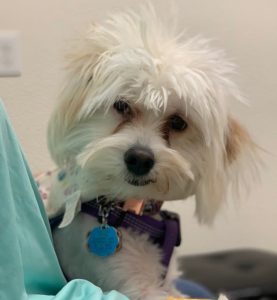Itchy Pet Month: All About Pruritus
There are few things worse than an itchy pet. Itchiness, referred to medically as pruritus, is a source of frustration for both owners and veterinarians. Fortunately, there are many supplements, over-the-counter medications and shampoos that are directed at our itchy pets. There is also no shortage of foods that purport to relieve itching. And although most of the over-the-counter options and foods can be helpful, many pet owners are still left frustrated because the symptoms persist.
In this blog we will cover:
- What Causes Pruritus
- How to Treat Pruritus in Dogs
- Itch Relief for Dogs
 What Causes Pruritus in Dogs?
What Causes Pruritus in Dogs?
The problem is that not all itchy pets are the same – there are many different things that can cause pruritus. For instance, fleas, mites, environmental allergies, food allergies and even an immune-mediated cause can result in an itchy pet. It’s a very frustrating issue if you are buying expensive food, shampooing daily w/ an “anti-itch” shampoo, and giving Benadryl, but your pet is still scratching due to mites. However, going about this logically and step-by-step can get the itchiness addressed and improve the quality of life for both your pet and you.
How To Treat Pruritus in Dogs
The first step is a visit your veterinarian. There are easy tests that your veterinarian can do to either eliminate causes or sometimes even determine what the cause ultimately is. If your pet has mites, those are easily treated now with an oral medication, and there is no need for diet changes or “allergy shots”. But if it is determined that your pet does likely have environmental allergies that will unfortunately likely be a life-long, seasonal issue. Having your veterinarian involved to help guide you on what antihistamine or possibly diet to be on can be incredibly helpful. Many times, pet itchiness is caused by allergies. Typically, your veterinarian will use the following steps to address your pet’s itchiness:
1. Ensure your pet is on a good oral external parasite control
To make sure that we are not running around in circles on treatments, your itchy pet must be on an oral flea and tick preventative. (Bravecto, Nexguard or a combination product like Simparica Trio are all great examples of these preventatives.) Using one of these products can ensure that the issue is not fleas or mites and provide us with the peace of mind that it won’t become a problem later.
There is also a potential issue of flea allergy dermatitis. Fleas will cause all pets to be itchy, and some pets are even allergic to the flea saliva. This means that even just a few bites from a couple fleas can cause a huge issue for them. Keeping your pet on parasite preventative products will keep them off your pets and away from your environment if used regularly.
 2. Treat All Underlying Skin Conditions Causing Pruritus
2. Treat All Underlying Skin Conditions Causing Pruritus
Pets can tend to scratch themselves raw, which is literally self-traumatizing. Pair that with an already unhealthy surface of the skin, and it is a great situation for an opportunistic infection. The surface of our pet’s skin is not sterile, because here are bacteria and even yeast living on it. Most time these bacteria don’t cause a problem and can actually be healthy. However, it’s only healthy if pets have a healthy skin barrier to protect. If that barrier is broken, and an abrasion occurs that is bleeding, now those natural bacteria will blossom out of control, causing an infection. If pets do this, it is imperative that it is addressed w/ antibiotics or antifungals. Any treatments for allergies will be unsuccessful if there is an active infection going on. Therefore, determining if there is an infection and addressing it is necessary.
3. Treating Pruritus Due to Allergies Using Apoquel for Dogs (and more)
At this point in a treatment plan, we are often getting to the problem that is most visualized by owners…the itching. Thankfully we have many medications at our disposal that can be used. This is where over-the-counter products like Benadryl, Zyrtec, and Famotidine come in, along with prescription medications like Hydroxyzine, Apoquel and Cytopoint. There are also steroids. And although steroids will commonly help, they are often at a severe cost, in terms of side-effects. And thus, are not recommended as a long-term management plan. Apoquel and CytoPoint are two of the newest allergy medications that have demonstrated extremely favorable results. Apoquel is an oral tablet given once to twice a day, and CytoPoint is an injectable medication providing relief from pruritus due to allergies for up to 12 weeks! Both medications work on the cascade of chemicals that cause a pet to itch, but at different levels. They are quite different. And thus, some pets respond better to one over the other, and still some patients use them both.
4. Maintain Control of Pruritus in Dogs
Hopefully, at this point in our treatment plan we’ve seen some positive results. This can also be the frustrating part for pet owners and veterinarians. Perhaps it’s taken 1-2 weeks with the itching controlled, but the problem is not actually gone. This is because the pet body is going to continue to be exposed to those environmental allergens. None of the treatments have desensitized our pets to the allergens, which means that the itching will resume when the medications wear off. This step merges with step 3, as it is often necessary for pets to remain on Apoquel or receive routine CytoPoint injections. Our goal would be to get the inflammatory process “knocked” down enough such that it can be maintained, with less expensive and easier to obtain medications like OTC medications. But unfortunately, pets frequently need those prescription medications. What we really don’t want to do is to wait until the pruritus has become so severe again to allow for those secondary infections to occur. It is very important to realize that we will never “cure” a patient of allergies, they are treated and managed.
 5. Continue to Create a Strong Defense Against Pruritus
5. Continue to Create a Strong Defense Against Pruritus
At this point in the treatment of our itchy dog, we hopefully have a pet that is no longer itching, and their coat is growing back, because they are on a regular external parasite control and have no external wounds. But maybe they are still dealing with a bit of dry or oily skin. Although that isn’t necessarily a huge problem, it is an indication that the skin is not as healthy as it could be. So, what can we do to get the skin and coat healthy? This is where over-the-counter supplements and shampoos really come into play. Things like fish oil capsules, essential fatty acids (EFA)/Omega-3 supplements, probiotics, hydrating shampoos can all be very helpful. These things in combination with flea and mite prevention and allergy treatments will help the skin and coat to be more healthy and more resistant to the severe damage that allergies may cause.
6. Evaluating Food For Dogs With Itchy Skin
There are multiple facets to the topic of food as it relates to pruritic pets, the first being food allergies. Food allergies exist and are typically to beef or chicken. However, true food allergies only account for about 5-10% of pruritic patients. True food allergies will not respond to the therapy, because the pet needs a different food without the protein that they are allergic to. Often, it is not necessarily a food allergy, but an issue with unhealthy quality of food. This means that it is usually best to switch you pet to a food that is a healthier version of the one you were previously using.
 Itch Relief for Dogs
Itch Relief for Dogs
A pruritic pet is one of the most frustrating things for a pet owner to deal with. For one we see our pets experiencing discomfort, and it hurts to see them uncomfortable. Additionally, it often results in our pets having an unhealthy skin and coat, and consequently we don’t really want to snuggle with them. When itchy pets go untreated, we start getting frustrated by the distraction of them scratching all the time. All of this results in an obvious decline in the pet’s quality of life, as well as yours. We have our pets to improve not only their quality of life but bring joy to ours. Allergies can be a big barrier to that. But it is not a situation that is unmanageable. If approached in systematic fashion with your veterinarian, we can often turn the situation around and create a completely different dynamic for you and your pet.
